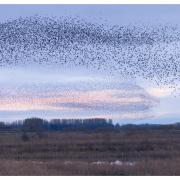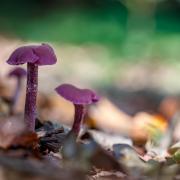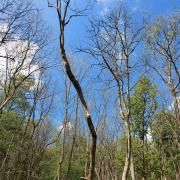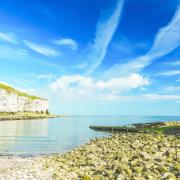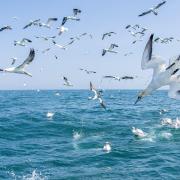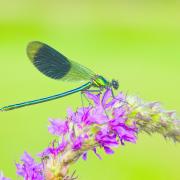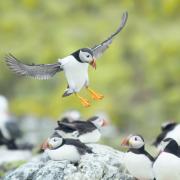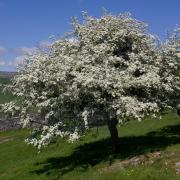Tom Marshall of Yorkshire Wildlife Trust picks some of the best wildlife and outdoor experiences for the year ahead

A sense of porpoise – Scarborough
Scarborough’s Marine Drive (or more specifically the patch of North Sea just beyond it) is one of the finest places in northern England to glimpse our smallest cetacean – the harbour porpoise. Sometimes remarkably close in shore, look out for parents and youngsters on calm summer days.

Purple patch – Flamborough
The cliffs of Flamborough need no introduction for their comical residents, the puffins, but a trip to North Landing and Briel Nook in May will also be rewarded with a profusion of purple orchids just moments from the car park. Skylarks provide the soundtrack to this colourful display.

Once bittern – Old Moor, Doncaster
The Dearne Valley is building an enviable reputation as one of the finest places in Yorkshire to spot a secretive bittern during spring and summer. A number of pairs bred in 2016, with regular feeding flights enjoyed from a variety of well-placed hides.

It’s getting otter – Tophill Low, Driffield
After a visit to the new visitor centre, head to the otter hide where these sought-after creatures can make an appearance. A supporting cast of barn owls and kingfishers can also add to the show.

Ouzel clever boy – Rosedale Moor
The ring ouzel or ‘mountain blackbird’ returns to Yorkshire in March, and for a few short weeks you may get a glimpse of these rare visitors as they sing atop mountain ash and other trees among the jagged, rocky moorland edge.

Vole in the wall – Redmires, Sheffield
Wyming Brook and other inlets to the Redmires Reservoir complex play host to ‘Ratty’ the water vole. A range of trails follow the bankside so listen for the distinctive ‘plop’ or noisy chewing!

Winging it – Brockadale, Pontefract
With its gently warmed, sunny, south facing slopes, the flower-rich meadows of Brockadale are alive with butterflies during spring and summer. Marbled whites can abound in their hundreds, with the stunning dark green fritillary choosing quieter corners. Tiny skippers are joined by the wonderfully-named painted lady and peacock among many more.

Let us prey – Wykeham Valley
East of Scarborough, the sweeping valley of Wykeham with its wooded escarpments is a popular aerial playground for birds of prey, keen to catch thermals as they deliver perfect air to glide on. Buzzards, kestrels and sparrowhawks are here, while occasional red kites and migrating ospreys may make a summertime appearance. Magnificent goshawks are a real treat, along with the occasional honey buzzard, and the tiny merlin.

Seal the deal – Whitby, Filey, Bridlington
A range of locally-skippered boat trips can get you eye-to-eye with grey seals and their youngsters beneath the Dover-beating 400ft high white cliffs of the Yorkshire coast. A low-tide walk at Filey and the famous brigg may also find you face-to-face with a snoozing seal in autumn. Be sure to give them space and respect.

Stag do – Studley Royal, Ripon
Each October, male deer strut their stuff in a bid to gain control of a harem of females for the season ahead. Kings of the hill are the formidable red deer stags with an impressive array of antlers, while fallow deer and smaller sika deer are also in attendance on this stage of furry testosterone.

Knock on wood – Adel Dam, Leeds
Close to the city, the knarled trees of Adel Dam are a favourite haunt of woodpeckers. Great spotted woodpeckers may start drumming as early as January, and the area also provides a chance to seek out the sparrow-sized and increasingly scarce lesser spotted woodpecker, high among the canopy.

Go nuts for squirrels – Snaizeholme, Yorkshire Dales
Smaller than its non-native American cousin, the tuft-eared and diminutive red squirrel finds refuge in just a few special places in Britain, including the Dales. Self-guided trails and a feeding station increase your chances of a glimpse.

Leap of faith – Stainforth Force, Yorkshire Dales
Every autumn, as river levels rise around the county, Atlantic salmon begin their almost impossible and relentless migration upstream to our uplands. At Stainforth and other waterfalls, watch their remarkable leaps into the rushing waters (best in the early morning or evening after recent rains).

Seabird cities – Flamborough Headland
Perhaps Yorkshire’s headline act when it comes to wildlife, the puffins of Bempton and Flamborough Cliffs remain a huge draw from April-July each year. In contrast to their diminutive size, sitting alongside them with a 6ft wingspan you’ll find England’s only mainland colony of gannets – our largest seabird. A supporting cast of guillemots, kittiwakes and more makes this an unmissable sensory experience.

Mighty minkes – Whitby and Staithes
As our nesting seabirds begin to depart in late summer, beneath the waves a new group of visitors arrive to steal the limelight – whales and dolphins. Led by 30ft minke whales, occasionally in the company of pods of white-beaked dolphins, this underwater feeding extravaganza is driven by millions of spawning fish. Boat trips from Whitby and Staithes can get you right in the heart of the action just a few miles offshore.

Top of the bill – Humber Estuary
Hull may be the city of culture, but the estuary shores of the Humber can put on a show any day of the year. Starling murmurations, thousands-strong, can mesmerise in winter, while the iconic avocet and stunning bearded tit make a home here. Countless wading birds with their perfectly adapted long beaks gather at the unmistakeable Spurn, all under the watchful eye of peregrines, merlins and harriers.

A mere delight – Hornsea
Tucked away on the Holderness coast, Hornsea Mere is our largest freshwater lake, longer than the medieval walls of York. The tranquil lakeside welcomes reedbed specialists like the marsh harrier, bittern and cettis warbler, while otters can appear before the viewing hide at Wassand Estate. Open water in winter attracts a myriad striking ducks and swans, along with sea-going divers and mergansers seeking refuge.












